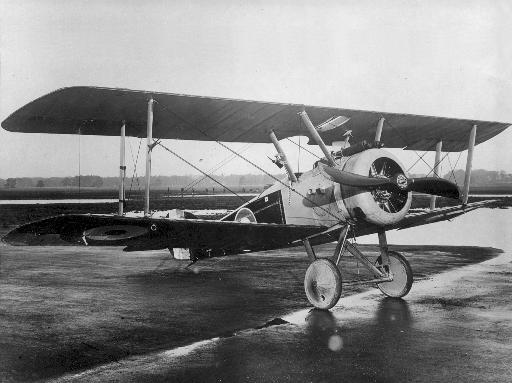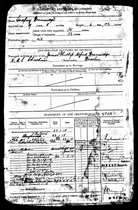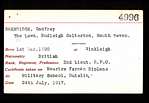Godfrey Bremridge was born on 1st March 1895. He was the second child of Henry Bremridge, the vicar of Winkleigh and his wife Dora who had come from a family in Cheshire near Manchester. Unfortunately, Dora died with the birth of Godfrey. Godfrey’s older brother James is also on the Roll of Honour. Thus neither of the sons had any real memory of their mother. Their father Henry did not re-marry until nearly six years later to Charlotte May Roby Godwin who was half Henry’s age at the time. The Bremridge family was relatively wealthy so the two boys most probably had the best of care as their uncle, aunt and their daughter had come to stay in Winkleigh to look after them, but they still lacked a true mother. In Winkleigh, the vicar had a splendid vicarage set in its own grounds together with Glebe which consisted of 8.5 acres of farmland which provided additional income. It was normal for boys of such families to join the church or enter the forces.
It s not known when joined the army, but his army medal record card shows that in 1914 he was in the Army Service Corps serving in Egypt. He continued to serve in Egypt in 1915 but does not show when he returned. It appears that Godfrey’s army service record was destroyed in the fire during the second World War that destroyed so many army service records. However, his Royal Air Force service record starts in July 1917 when he is posted to 65 Squadron. However, as the foundation of the RAF was not until 1st April 1918. we do not know exactly when he first transferred to the Royal Flying Corps. His first Pilot’s Certificate is dated 24 July 1917 at the Military School in Ruislip and he is described as a 2nd Lieutenant in the Royal Flying Corps. There are notes dated early in 1918, regarding his flying experience in several types of aircraft.
At the end of July 1917, Godfrey was posted to 65 Squadron. At this time, the squadron was still at its original base at Wyton in Norfolk where it performed mostly training operations. In October the squadron received Sopwith Camels and moved to France where it spent a period of flying defensive patrols over the Western Front. February 1918, it began ground attack missions with light bombs on enemy troops and battlefield positions. In August 1918, it moved to the Belgian coastal sector and provided escorts for day bombers attacking enemy bases. During the last weeks of the war it covered the Allied advance into Belgium and returned to the Yatesbury in February 1919, where it disbanded on 25 October 1919.

The Sopwith F.1 Camel was an agile, highly manoeuvrable biplane and accounted for more aerial victories than any other Allied aircraft during World War I. Credited with destroying 1,294 enemy aircraft, it was called the Camel due to the humped fairing over its twin machine guns. Much like a real camel, this aircraft could turn and bite you. Noted for its tendency to kill inexperienced flyers, many pilots feared its vicious spin characteristics. Until sufficient speed was developed during takeoff, Camel pilots maintained full right rudder to counteract the torque the rotary engine. Failure to do so often resulted in a ground loop with the Camel crashing on its starboard wingtip. During World War I, 413 pilots died in combat and 385 pilots died from non-combat related causes while flying the Sopwith Camel.
By he end of the war, 65 squadron had claimed over 200 victories and was noted for having 13 aces serving with it, one of whom was Godfrey Bremridge. He drove down three enemy airplanes between 18 December 1917 and 9 March 1918, destroyed two others later and shared three more victories with other pilots. He was awarded the Air Force Cross for his courage and tenacity which was announced in the London Gazette on 1st January 1919. After the war he emigrated to Tkrona Park, White River, East Transvaal in South Africa where he started an orange farm, became father to 2 daughters and a son, John Henry.
In the thirties, the family returned to England while the children went through school. In 1934 he renewed his British Pilot’s Certificate at Brooklands Flying Club. With onset of the second world war in 1939, he re-joined the RAF, this time as a Pilot Instructor of vast experience and was a great asset to the Air Force who were in great need of additional pilots. Ironically, Godfrey Bremridge was killed doing what he loved best, in a flying accident on 12 September 1941. He was buried at the churchyard of St Peter & St Paul at Sywell, Northamptonshire.
1 October 2013




